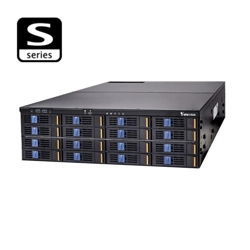Loading ...
Loading ...
Loading ...

VIVOTEK - A Leading Provider of Multimedia Communication Solutions
User's Manual - 43
Disk Mirroring
With disk mirroring (used in RAID 1 and RAID 10), data written to one drive is simultaneously
written to another drive. The primary advantage of disk mirroring is that it provides 100 percent
data redundancy. Because the contents of the disk are completely written to a second disk, data
is not lost if one disk fails. In addition, both drives contain the same data at all times, so either
disk can act as the operational disk. If one disk fails, the contents of the other disk can run the
system and reconstruct the failed disk.
Disk mirroring provides 100 percent redundancy, but it is expensive because each drive in the
system must be duplicated. The following gure shows an example of disk mirroring.
Stripe Width
Stripe width is the number of drives involved in a drive group where striping is implemented. For
example, a four-disk drive group with disk striping has a stripe width of four.
Stripe Size
The stripe size is the length of the interleaved data segments that the RAID controller writes
across multiple drives, not including parity drives. For example, consider a stripe that contains
1 MB of drive space and has 64 KB of data residing on each drive in the stripe. In this case, the
stripe size is 1 MB and the strip size is 64 KB.
Strip Size
The strip size is the portion of a stripe that resides on a single drive.
Parity
Parity generates a set of redundancy data from two or more parent data sets. The redundancy
data can be used to reconstruct one of the parent data sets in the event of a drive failure. Parity
data does not fully duplicate the parent data sets, but parity generation can slow the write
process. In a RAID drive group, this method is applied to entire drives or stripes across all of the
drives in a drive group. The types of parity are described in the following table.
Loading ...
Loading ...
Loading ...
